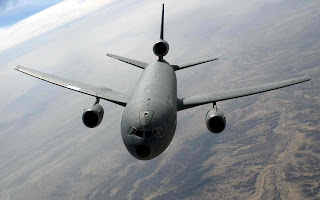The McDonnell Douglas KC-10 Extender is an aerial refueling tanker aircraft operated by the United States Air Force (USAF). A military version of the three-engined DC-10 airliner, the KC-10 was developed from the Advanced Tanker Cargo Aircraft Program. It incorporates military-specific equipment for its primary roles of transport and aerial refueling. It was developed to supplement the KC-135 Stratotanker following experiences in Southeast Asia and the Middle East. The KC-10 was the second McDonnell Douglas transport aircraft to be selected by the Air Force following the C-9. A total of 60 KC-10s were produced for the USAF. The Royal Netherlands Air Force operates two similar tankers designated KDC-10 that were converted from DC-10s.
 The KC-10 plays a key role in the mobilization of US military assets, taking part in overseas operations far from home. These aircraft performed airlift and aerial refueling during the 1986 bombing of Libya (Operation Eldorado Canyon), the 1990–91 Gulf War with Iraq (Operations Desert Shield and Desert Storm), the NATO bombing of Yugoslavia (Operation Allied Force), War in Afghanistan (Operation Enduring Freedom), and Iraq War (Operations Iraqi Freedom and New Dawn). The KC-10 is expected to serve until 2043.
The KC-10 plays a key role in the mobilization of US military assets, taking part in overseas operations far from home. These aircraft performed airlift and aerial refueling during the 1986 bombing of Libya (Operation Eldorado Canyon), the 1990–91 Gulf War with Iraq (Operations Desert Shield and Desert Storm), the NATO bombing of Yugoslavia (Operation Allied Force), War in Afghanistan (Operation Enduring Freedom), and Iraq War (Operations Iraqi Freedom and New Dawn). The KC-10 is expected to serve until 2043.
The KC-10 Extender first flew on 12 July 1980, but it was not until October the same year that the first aerial refuel sortie was performed. The design for the KC-10 involved modifications from the DC-10-30CF design. Unnecessary airline features were replaced by an improved cargo-handling system and military avionics. Meanwhile, the KC-10 retains 88% commonality with its commercial counterparts, giving it greater access to the worldwide commercial support system. Other changes from the DC-10-30CF include the removal of most windows and lower cargo doors. Early aircraft featured a distinctive light gray, white and blue paint scheme, but a gray-green camouflage scheme was used on later tankers. The paint scheme was switched to a medium gray color by the late 1990s.
 The KC-10 plays a key role in the mobilization of US military assets, taking part in overseas operations far from home. These aircraft performed airlift and aerial refueling during the 1986 bombing of Libya (Operation Eldorado Canyon), the 1990–91 Gulf War with Iraq (Operations Desert Shield and Desert Storm), the NATO bombing of Yugoslavia (Operation Allied Force), War in Afghanistan (Operation Enduring Freedom), and Iraq War (Operations Iraqi Freedom and New Dawn). The KC-10 is expected to serve until 2043.
The KC-10 plays a key role in the mobilization of US military assets, taking part in overseas operations far from home. These aircraft performed airlift and aerial refueling during the 1986 bombing of Libya (Operation Eldorado Canyon), the 1990–91 Gulf War with Iraq (Operations Desert Shield and Desert Storm), the NATO bombing of Yugoslavia (Operation Allied Force), War in Afghanistan (Operation Enduring Freedom), and Iraq War (Operations Iraqi Freedom and New Dawn). The KC-10 is expected to serve until 2043.The KC-10 Extender first flew on 12 July 1980, but it was not until October the same year that the first aerial refuel sortie was performed. The design for the KC-10 involved modifications from the DC-10-30CF design. Unnecessary airline features were replaced by an improved cargo-handling system and military avionics. Meanwhile, the KC-10 retains 88% commonality with its commercial counterparts, giving it greater access to the worldwide commercial support system. Other changes from the DC-10-30CF include the removal of most windows and lower cargo doors. Early aircraft featured a distinctive light gray, white and blue paint scheme, but a gray-green camouflage scheme was used on later tankers. The paint scheme was switched to a medium gray color by the late 1990s.
The most notable changes were the addition of the McDonnell Douglas Advanced Aerial Refueling Boom (AARB) and additional fuel tanks located in the baggage compartments below the main deck. The extra tanks increase the KC-10's fuel capacity to 356,000 lb (161,478 kg), nearly doubling the KC-135's capacity. The KC-10 has both a centerline refueling boom—unique in that it sports a control surface system at its aft end that differs from the V-tail design used on previous tankers—and a drogue-and-hose system on the starboard side of the rear fuselage. The KC-10 boom operator is located in the rear of the aircraft with a wide window for monitoring refueling. The operator controls refueling operations through a digital fly-by wire system. More details